Neural Networks and Deep Learning(week3)Planar data classification with one hidden layer(基于单隐藏层神经网络的平面数据分类)
Planar data classification with one hidden layer
你会学习到如何:
-
用单隐层实现一个二分类神经网络
-
使用一个非线性激励函数,如 tanh
-
计算交叉熵的损失值
-
实现前向传播和后向传播
1 - Packages(导入包)
需要导入的包:
- numpy:Python中的常用的科学计算库
- sklearn:提供简单而高效的数据挖掘和数据分析工具
- matplotlib:Python中绘图库
- testCases: 提供了一些测试例子来评估函数的正确性
- planar_utils: 提供各种有用的在这个任务中使用的函数
# Package imports
import numpy as np
import matplotlib.pyplot as plt
from testCases import *
import sklearn
import sklearn.datasets
import sklearn.linear_model
from planar_utils import plot_decision_boundary, sigmoid, load_planar_dataset, load_extra_datasets
%matplotlib inline
np.random.seed(1) # set a seed so that the results are consistent
% testCases.py 保存在本地 ```python import numpy as np def layer_sizes_test_case(): np.random.seed(1) X_assess = np.random.randn(5, 3) Y_assess = np.random.randn(2, 3) return X_assess, Y_assess def initialize_parameters_test_case(): n_x, n_h, n_y = 2, 4, 1 return n_x, n_h, n_y def forward_propagation_test_case(): np.random.seed(1) X_assess = np.random.randn(2, 3) parameters = {'W1': np.array([[-0.00416758, -0.00056267], [-0.02136196, 0.01640271], [-0.01793436, -0.00841747], [ 0.00502881, -0.01245288]]), 'W2': np.array([[-0.01057952, -0.00909008, 0.00551454, 0.02292208]]), 'b1': np.array([[ 0.], [ 0.], [ 0.], [ 0.]]), 'b2': np.array([[ 0.]])} return X_assess, parameters def compute_cost_test_case(): np.random.seed(1) Y_assess = np.random.randn(1, 3) parameters = {'W1': np.array([[-0.00416758, -0.00056267], [-0.02136196, 0.01640271], [-0.01793436, -0.00841747], [ 0.00502881, -0.01245288]]), 'W2': np.array([[-0.01057952, -0.00909008, 0.00551454, 0.02292208]]), 'b1': np.array([[ 0.], [ 0.], [ 0.], [ 0.]]), 'b2': np.array([[ 0.]])} a2 = (np.array([[ 0.5002307 , 0.49985831, 0.50023963]])) return a2, Y_assess, parameters def backward_propagation_test_case(): np.random.seed(1) X_assess = np.random.randn(2, 3) Y_assess = np.random.randn(1, 3) parameters = {'W1': np.array([[-0.00416758, -0.00056267], [-0.02136196, 0.01640271], [-0.01793436, -0.00841747], [ 0.00502881, -0.01245288]]), 'W2': np.array([[-0.01057952, -0.00909008, 0.00551454, 0.02292208]]), 'b1': np.array([[ 0.], [ 0.], [ 0.], [ 0.]]), 'b2': np.array([[ 0.]])} cache = {'A1': np.array([[-0.00616578, 0.0020626 , 0.00349619], [-0.05225116, 0.02725659, -0.02646251], [-0.02009721, 0.0036869 , 0.02883756], [ 0.02152675, -0.01385234, 0.02599885]]), 'A2': np.array([[ 0.5002307 , 0.49985831, 0.50023963]]), 'Z1': np.array([[-0.00616586, 0.0020626 , 0.0034962 ], [-0.05229879, 0.02726335, -0.02646869], [-0.02009991, 0.00368692, 0.02884556], [ 0.02153007, -0.01385322, 0.02600471]]), 'Z2': np.array([[ 0.00092281, -0.00056678, 0.00095853]])} return parameters, cache, X_assess, Y_assess def update_parameters_test_case(): parameters = {'W1': np.array([[-0.00615039, 0.0169021 ], [-0.02311792, 0.03137121], [-0.0169217 , -0.01752545], [ 0.00935436, -0.05018221]]), 'W2': np.array([[-0.0104319 , -0.04019007, 0.01607211, 0.04440255]]), 'b1': np.array([[ -8.97523455e-07], [ 8.15562092e-06], [ 6.04810633e-07], [ -2.54560700e-06]]), 'b2': np.array([[ 9.14954378e-05]])} grads = {'dW1': np.array([[ 0.00023322, -0.00205423], [ 0.00082222, -0.00700776], [-0.00031831, 0.0028636 ], [-0.00092857, 0.00809933]]), 'dW2': np.array([[ -1.75740039e-05, 3.70231337e-03, -1.25683095e-03, -2.55715317e-03]]), 'db1': np.array([[ 1.05570087e-07], [ -3.81814487e-06], [ -1.90155145e-07], [ 5.46467802e-07]]), 'db2': np.array([[ -1.08923140e-05]])} return parameters, grads def nn_model_test_case(): np.random.seed(1) X_assess = np.random.randn(2, 3) Y_assess = np.random.randn(1, 3) return X_assess, Y_assess def predict_test_case(): np.random.seed(1) X_assess = np.random.randn(2, 3) parameters = {'W1': np.array([[-0.00615039, 0.0169021 ], [-0.02311792, 0.03137121], [-0.0169217 , -0.01752545], [ 0.00935436, -0.05018221]]), 'W2': np.array([[-0.0104319 , -0.04019007, 0.01607211, 0.04440255]]), 'b1': np.array([[ -8.97523455e-07], [ 8.15562092e-06], [ 6.04810633e-07], [ -2.54560700e-06]]), 'b2': np.array([[ 9.14954378e-05]])} return parameters, X_assess ```
% planar_utils.py 保存在本地 ```python import matplotlib.pyplot as plt import numpy as np import sklearn import sklearn.datasets import sklearn.linear_model def plot_decision_boundary(model, X, y): # Set min and max values and give it some padding x_min, x_max = X[0, :].min() - 1, X[0, :].max() + 1 y_min, y_max = X[1, :].min() - 1, X[1, :].max() + 1 h = 0.01 # Generate a grid of points with distance h between them xx, yy = np.meshgrid(np.arange(x_min, x_max, h), np.arange(y_min, y_max, h)) # Predict the function value for the whole grid Z = model(np.c_[xx.ravel(), yy.ravel()]) Z = Z.reshape(xx.shape) # Plot the contour and training examples plt.contourf(xx, yy, Z, cmap=plt.cm.Spectral) plt.ylabel('x2') plt.xlabel('x1') plt.scatter(X[0, :], X[1, :], c=y.ravel(), cmap=plt.cm.Spectral) def sigmoid(x): """ Compute the sigmoid of x Arguments: x -- A scalar or numpy array of any size. Return: s -- sigmoid(x) """ s = 1/(1+np.exp(-x)) return s def load_planar_dataset(): np.random.seed(1) m = 400 # number of examples N = int(m/2) # number of points per class D = 2 # dimensionality X = np.zeros((m,D)) # data matrix where each row is a single example Y = np.zeros((m,1), dtype='uint8') # labels vector (0 for red, 1 for blue) a = 4 # maximum ray of the flower for j in range(2): ix = range(N*j,N*(j+1)) t = np.linspace(j*3.12,(j+1)*3.12,N) + np.random.randn(N)*0.2 # theta r = a*np.sin(4*t) + np.random.randn(N)*0.2 # radius X[ix] = np.c_[r*np.sin(t), r*np.cos(t)] Y[ix] = j X = X.T Y = Y.T return X, Y def load_extra_datasets(): N = 200 noisy_circles = sklearn.datasets.make_circles(n_samples=N, factor=.5, noise=.3) noisy_moons = sklearn.datasets.make_moons(n_samples=N, noise=.2) blobs = sklearn.datasets.make_blobs(n_samples=N, random_state=5, n_features=2, centers=6) gaussian_quantiles = sklearn.datasets.make_gaussian_quantiles(mean=None, cov=0.5, n_samples=N, n_features=2, n_classes=2, shuffle=True, random_state=None) no_structure = np.random.rand(N, 2), np.random.rand(N, 2) return noisy_circles, noisy_moons, blobs, gaussian_quantiles, no_structure ```
2 - Dataset(导入数据集)
首先,我们导入需要工作的数据。下面的代码将导入一个 "flower"二分类数据集到变量 X 和 Y.
X, Y = load_planar_dataset()
使用matplotlib可视化数据集。数据看起来像一朵“花”,上面有一些红色(标签y=0)和一些蓝色(y=1)点。您的目标是建立一个适合这些数据的模型。
# Visualize the data: c: 颜色;s:线宽; cmap:模块pyplot内置了一组颜色映射
plt.scatter(X[0, :], X[1, :], c=Y.reshape(400), s=40, cmap=plt.cm.Spectral);
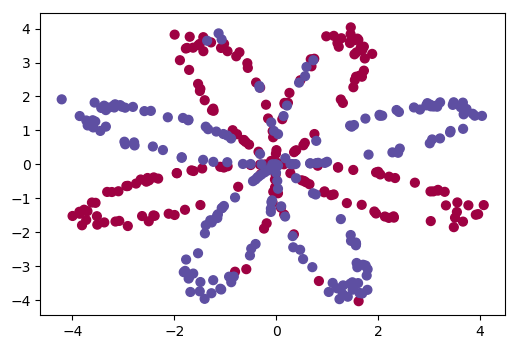
你有:
- 一个 numpy-array (矩阵)X: 包含你的特征(x1, x2)
- 一个 numpy-array (向量)Y: 包含你的标签(red:0, blue:1).
来第一次得到更好的数据是什么样子的感觉:
Exercise: 你有多少训练样本?另外,X和Y的维度是什么?
### START CODE HERE ### (≈ 3 lines of code)
shape_X = X.shape
shape_Y = Y.shape
m = shape_X[1] # training set size
### END CODE HERE ###
print ('The shape of X is: ' + str(shape_X))
print ('The shape of Y is: ' + str(shape_Y))
print ('I have m = %d training examples!' % (m))
The shape of X is: (2, 400)
The shape of Y is: (1, 400)
I have m = 400 training examples!
Expected Output:
| shape of X | (2, 400) |
| shape of Y | (1, 400) |
| m | 400 |
3 - Simple Logistic Regression(简单的逻辑回归)
在建立一个完整的神经网络之前,让我们先看看逻辑回归在这个问题上的表现。可以使用sklearn的内置函数来实现这一点。运行下面的代码来训练数据集上的逻辑回归分类器。
# Train the logistic regression classifier
clf = sklearn.linear_model.LogisticRegressionCV();
clf.fit(X.T, Y.T);
3.1 绘制这些模型的决策边界
# Plot the decision boundary for logistic regression
plot_decision_boundary(lambda x: clf.predict(x), X, Y)
plt.title("Logistic Regression")
# Print accuracy
LR_predictions = clf.predict(X.T)
print ('Accuracy of logistic regression: %d ' % float((np.dot(Y,LR_predictions) + np.dot(1-Y,1-LR_predictions))/float(Y.size)*100) +
'% ' + "(percentage of correctly labelled datapoints)")
解释:数据集不是线性可分的,所以逻辑回归不表现良好。希望一个神经网络能做得更好。现在让我们试试这个!
4 - Neural Network model(神经网络模型)
Logistic回归在“flower dataset”上效果不佳。你要训练一个只有一个隐藏层的神经网络
Here is our model:
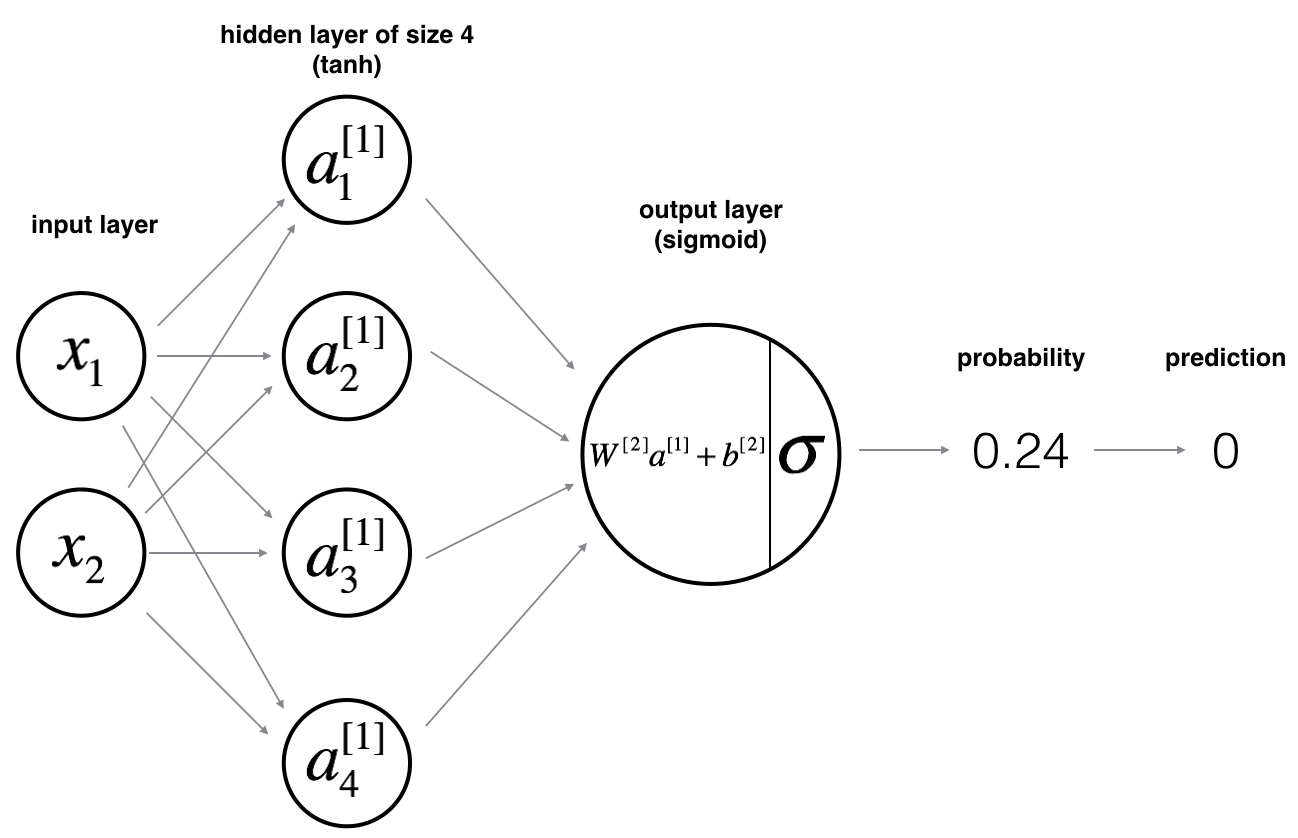
Mathematically:
For one example x(i):

提醒:建立神经网络的一般方法是:
- 定义神经网络结构(神经网络的输入单元,隐藏单元,输出单元等)
- 随机初始化模型的参数
- 循环:
-
- 实现前向传播
- 计算损失值
- 实现后向传播来获得梯度值
- 更新参数(梯度下降)
构建helper函数来计算步骤1-3,然后融合他们为一个 nn_model()函数。学习正确的参数,你可以在新数据上做出预测。
4.1 - Defining the neural network structure
Exercise: Define three variables:
- n_x: 输入层的大小
- n_h: 隐藏层的大小(设置为4)
- n_y: 输出层的大小
Hint: 使用X 和 Y 的维度来计算 n_x, n_y。隐藏层大小设置为4
# GRADED FUNCTION: layer_sizes
def layer_sizes(X, Y):
"""
Arguments:
X -- input dataset of shape (input size, number of examples)
Y -- labels of shape (output size, number of examples)
Returns:
n_x -- the size of the input layer
n_h -- the size of the hidden layer
n_y -- the size of the output layer
"""
### START CODE HERE ### (≈ 3 lines of code)
n_x = X.shape[0] # size of input layer
n_h = 4
n_y = Y.shape[0] # size of output layer
### END CODE HERE ###
return (n_x, n_h, n_y)
X_assess, Y_assess = layer_sizes_test_case()
(n_x, n_h, n_y) = layer_sizes(X_assess, Y_assess)
print("The size of the input layer is: n_x = " + str(n_x))
print("The size of the hidden layer is: n_h = " + str(n_h))
print("The size of the output layer is: n_y = " + str(n_y))
The size of the input layer is: n_x = 5
The size of the hidden layer is: n_h = 4
The size of the output layer is: n_y = 2
Expected Output (these are not the sizes you will use for your network, they are just used to assess the function you've just coded).
| n_x | 5 |
| n_h | 4 |
| n_y | 2 |
4.2 - Initialize the model's parameters(初始化模型参数)
Exercise: Implement the function initialize_parameters().
Instructions:
- 确认你的参数正确。
- 使用 随机值初始化权重矩阵。
- 使用: np.random.randn(a,b) * 0.01 来随机初始化(a, b)维度的矩阵。
- 把 偏置向量初始化为零。
- 使用: np.zeros((a,b)) 用 0 初始化(a, b) 维度的矩阵
# GRADED FUNCTION: initialize_parameters
def initialize_parameters(n_x, n_h, n_y):
"""
Argument:
n_x -- size of the input layer
n_h -- size of the hidden layer
n_y -- size of the output layer
Returns:
params -- python dictionary containing your parameters:
W1 -- weight matrix of shape (n_h, n_x)
b1 -- bias vector of shape (n_h, 1)
W2 -- weight matrix of shape (n_y, n_h)
b2 -- bias vector of shape (n_y, 1)
"""
np.random.seed(2) # we set up a seed so that your output matches ours although the initialization is random.
### START CODE HERE ### (≈ 4 lines of code)
W1 = np.random.randn(n_h, n_x) * 0.01
b1 = np.zeros(shape=(n_h, 1))
W2 = np.random.randn(n_y, n_h) * 0.01
b2 = np.zeros(shape=(n_y, 1))
### END CODE HERE ###
assert (W1.shape == (n_h, n_x))
assert (b1.shape == (n_h, 1))
assert (W2.shape == (n_y, n_h))
assert (b2.shape == (n_y, 1))
parameters = {"W1": W1,
"b1": b1,
"W2": W2,
"b2": b2}
return parameters
n_x, n_h, n_y = initialize_parameters_test_case()
parameters = initialize_parameters(n_x, n_h, n_y)
print("W1 = " + str(parameters["W1"]))
print("b1 = " + str(parameters["b1"]))
print("W2 = " + str(parameters["W2"]))
print("b2 = " + str(parameters["b2"]))
W1 = [[-0.00416758 -0.00056267]
[-0.02136196 0.01640271]
[-0.01793436 -0.00841747]
[ 0.00502881 -0.01245288]]
b1 = [[ 0.]
[ 0.]
[ 0.]
[ 0.]]
W2 = [[-0.01057952 -0.00909008 0.00551454 0.02292208]]
b2 = [[ 0.]]
Expected Output:
| W1 | [[-0.00416758 -0.00056267] [-0.02136196 0.01640271] [-0.01793436 -0.00841747] [ 0.00502881 -0.01245288]] |
| b1 | [[ 0.] [ 0.] [ 0.] [ 0.]] |
| W2 | [[-0.01057952 -0.00909008 0.00551454 0.02292208]] |
| b2 | [[ 0.]] |
4.3 - The Loop
Question: 实现前向传播 forward_propagation().
Instructions:
- 查看上面的数学公式表示你的分类器
- 使用 sigmoid()
- 你可以使用 function np.tanh() . 这是 numpy库的一部分
- 这些步骤你必须实现:
- 从字典 "parameters" (initialize_parameters()的输出)检索每个参数,用 parameters["..."]。
- 实现前向传播。计算:
 (所有训练集样本预测的向量)
(所有训练集样本预测的向量)
- 反向传播所需的值存储在“cache”。cache将作为反向传播函数的输入。
# GRADED FUNCTION: forward_propagation
def forward_propagation(X, parameters):
"""
Argument:
X -- input data of size (n_x, m)
parameters -- python dictionary containing your parameters (output of initialization function)
Returns:
A2 -- The sigmoid output of the second activation
cache -- a dictionary containing "Z1", "A1", "Z2" and "A2"
"""
# Retrieve each parameter from the dictionary "parameters"
### START CODE HERE ### (≈ 4 lines of code)
W1 = parameters["W1"]
b1 = parameters["b1"]
W2 = parameters["W2"]
b2 = parameters["b2"]
### END CODE HERE ###
# Implement Forward Propagation to calculate A2 (probabilities)
### START CODE HERE ### (≈ 4 lines of code)
Z1 = np.dot(W1, X) + b1
A1 = np.tanh(Z1)
Z2 = np.dot(W2, A1) + b2
A2 = sigmoid(Z2)
# print (W1.shape)
# print (X.shape)
# print (b1.shape)
# print ("A1:", A1.shape)
# print ("Z1:",Z1.shape)
# print ("Z2:", Z2.shape)
# print ("A2:", A2.shape)
### END CODE HERE ###
assert(A2.shape == (1, X.shape[1]))
cache = {"Z1": Z1,
"A1": A1,
"Z2": Z2,
"A2": A2}
return A2, cache
X_assess, parameters = forward_propagation_test_case()
A2, cache = forward_propagation(X_assess, parameters)
# Note: we use the mean here just to make sure that your output matches ours.
print(np.mean(cache['Z1']) ,np.mean(cache['A1']),np.mean(cache['Z2']),np.mean(cache['A2']))
Expected Output:
| 0.262818640198 0.091999045227 -1.30766601287 0.212877681719 |
现在你已经计算 (在Python变量“A2”中),其中包含了每个示例的
(在Python变量“A2”中),其中包含了每个示例的 ,你可以如下计算代价函数
,你可以如下计算代价函数

Exercise: Implement compute_cost() to compute the value of the cost J.
Instructions:
- 实现交叉熵损失(cross-entropy loss)的方法有很多种。我们如何实现

logprobs = np.multiply(np.log(A2),Y)
cost = - np.sum(logprobs) # no need to use a for loop!
# GRADED FUNCTION: compute_cost
def compute_cost(A2, Y, parameters):
"""
Computes the cross-entropy cost given in equation (13)
Arguments:
A2 -- The sigmoid output of the second activation, of shape (1, number of examples)
Y -- "true" labels vector of shape (1, number of examples)
parameters -- python dictionary containing your parameters W1, b1, W2 and b2
Returns:
cost -- cross-entropy cost given equation (13)
"""
m = Y.shape[1] # number of example
# Compute the cross-entropy cost
### START CODE HERE ### (≈ 2 lines of code)
logprobs = np.multiply(np.log(A2), Y) + np.multiply(np.log(1 - A2), 1 - Y)
cost = - np.sum(logprobs) / m
### END CODE HERE ###
cost = np.squeeze(cost) # makes sure cost is the dimension we expect.
# E.g., turns [[17]] into 17
assert(isinstance(cost, float))
return cost
A2, Y_assess, parameters = compute_cost_test_case()
print("cost = " + str(compute_cost(A2, Y_assess, parameters)))
Expected Output:
| cost | 0.693058761... |
Question: Implement the function backward_propagation().
Instructions: 下面提供6个公式矢量化的实现。

Tips:
计算 dZ1,你需要计算  。由于
。由于 是一个 tanh 激励函数,如果
是一个 tanh 激励函数,如果 
所以你可以用(1 - np.power(A1, 2)) 计算  。
。
# GRADED FUNCTION: backward_propagation
def backward_propagation(parameters, cache, X, Y):
"""
Implement the backward propagation using the instructions above.
Arguments:
parameters -- python dictionary containing our parameters
cache -- a dictionary containing "Z1", "A1", "Z2" and "A2".
X -- input data of shape (2, number of examples)
Y -- "true" labels vector of shape (1, number of examples)
Returns:
grads -- python dictionary containing your gradients with respect to different parameters
"""
m = X.shape[1]
# First, retrieve W1 and W2 from the dictionary "parameters".
### START CODE HERE ### (≈ 2 lines of code)
W1 = parameters["W1"]
W2 = parameters["W2"]
### END CODE HERE ###
# Retrieve also A1 and A2 from dictionary "cache".
### START CODE HERE ### (≈ 2 lines of code)
A1 = cache["A1"]
A2 = cache["A2"]
### END CODE HERE ###
# Backward propagation: calculate dW1, db1, dW2, db2.
### START CODE HERE ### (≈ 6 lines of code, corresponding to 6 equations on slide above)
dZ2 = A2 - Y
dW2 = (1 / m) * np.dot(dZ2, A1.T)
db2 = (1 / m) * np.sum(dZ2, axis=1, keepdims=True)
dZ1 = np.multiply(np.dot(W2.T, dZ2), 1 - np.power(A1, 2))
dW1 = (1 / m) * np.dot(dZ1, X.T)
db1 = (1 / m) * np.sum(dZ1, axis=1, keepdims=True)
### END CODE HERE ###
grads = {"dW1": dW1,
"db1": db1,
"dW2": dW2,
"db2": db2}
return grads
parameters, cache, X_assess, Y_assess = backward_propagation_test_case()
grads = backward_propagation(parameters, cache, X_assess, Y_assess)
print ("dW1 = "+ str(grads["dW1"]))
print ("db1 = "+ str(grads["db1"]))
print ("dW2 = "+ str(grads["dW2"]))
print ("db2 = "+ str(grads["db2"]))
dW1 = [[ 0.01018708 -0.00708701] [ 0.00873447 -0.0060768 ] [-0.00530847 0.00369379] [-0.02206365 0.01535126]] db1 = [[-0.00069728] [-0.00060606] [ 0.000364 ] [ 0.00151207]] dW2 = [[ 0.00363613 0.03153604 0.01162914 -0.01318316]] db2 = [[ 0.06589489]]
Expected output:
| dW1 | [[ 0.01018708 -0.00708701] [ 0.00873447 -0.0060768 ] [-0.00530847 0.00369379] [-0.02206365 0.01535126]] |
| db1 | [[-0.00069728] [-0.00060606] [ 0.000364 ] [ 0.00151207]] |
| dW2 | [[ 0.00363613 0.03153604 0.01162914 -0.01318316]] |
| db2 | [[ 0.06589489]] |
Question: 执行更新参数规则。使用梯度下降算法。你不得不使用 (dW1, db1, dW2, db2) 来更新 (W1, b1, W2, b2).
一般梯度下降规则: 。(α 是learning rate;θ 表示参数)
。(α 是learning rate;θ 表示参数)
Illustration: 梯度下降算法具有良好的学习速率(收敛) 和 差的学习速率(发散)。图片如下:.


# GRADED FUNCTION: update_parameters
def update_parameters(parameters, grads, learning_rate = 1.2):
"""
Updates parameters using the gradient descent update rule given above
Arguments:
parameters -- python dictionary containing your parameters
grads -- python dictionary containing your gradients
Returns:
parameters -- python dictionary containing your updated parameters
"""
# Retrieve each parameter from the dictionary "parameters"
### START CODE HERE ### (≈ 4 lines of code)
W1 = parameters["W1"]
b1 = parameters["b1"]
W2 = parameters["W2"]
b2 = parameters["b2"]
### END CODE HERE ###
# Retrieve each gradient from the dictionary "grads"
### START CODE HERE ### (≈ 4 lines of code)
dW1 = grads["dW1"]
db1 = grads["db1"]
dW2 = grads["dW2"]
db2 = grads["db2"]
## END CODE HERE ###
# Update rule for each parameter
### START CODE HERE ### (≈ 4 lines of code)
W1 = W1 - learning_rate * dW1
b1 = b1 - learning_rate * db1
W2 = W2 - learning_rate * dW2
b2 = b2 - learning_rate * db2
### END CODE HERE ###
parameters = {"W1": W1,
"b1": b1,
"W2": W2,
"b2": b2}
return parameters
parameters, grads = update_parameters_test_case()
parameters = update_parameters(parameters, grads)
print("W1 = " + str(parameters["W1"]))
print("b1 = " + str(parameters["b1"]))
print("W2 = " + str(parameters["W2"]))
print("b2 = " + str(parameters["b2"]))
Expected Output:
| W1 | [[-0.00643025 0.01936718] [-0.02410458 0.03978052] [-0.01653973 -0.02096177] [ 0.01046864 -0.05990141]] |
| b1 | [[ -1.02420756e-06] [ 1.27373948e-05] [ 8.32996807e-07] [ -3.20136836e-06]] |
| W2 | [[-0.01041081 -0.04463285 0.01758031 0.04747113]] |
| b2 | [[ 0.00010457]] |
4.4 - Integrate parts 4.1, 4.2 and 4.3 in nn_model()
Question: 在 nn_model() 里构建神经网络模型
Instructions: 神经网络模型必须按照正确的顺序使用前面的函数。
# GRADED FUNCTION: nn_model
def nn_model(X, Y, n_h, num_iterations=10000, print_cost=False):
"""
Arguments:
X -- dataset of shape (2, number of examples)
Y -- labels of shape (1, number of examples)
n_h -- size of the hidden layer
num_iterations -- Number of iterations in gradient descent loop
print_cost -- if True, print the cost every 1000 iterations
Returns:
parameters -- parameters learnt by the model. They can then be used to predict.
"""
np.random.seed(3)
n_x = layer_sizes(X, Y)[0]
n_y = layer_sizes(X, Y)[2]
# Initialize parameters, then retrieve W1, b1, W2, b2. Inputs: "n_x, n_h, n_y". Outputs = "W1, b1, W2, b2, parameters".
### START CODE HERE ### (≈ 5 lines of code)
parameters = initialize_parameters(n_x, n_h, n_y)
W1 = parameters['W1']
b1 = parameters['b1']
W2 = parameters['W2']
b2 = parameters['b2']
### END CODE HERE ###
# Loop (gradient descent)
for i in range(0, num_iterations):
### START CODE HERE ### (≈ 4 lines of code)
# Forward propagation. Inputs: "X, parameters". Outputs: "A2, cache".
A2, cache = forward_propagation(X, parameters)
# Cost function. Inputs: "A2, Y, parameters". Outputs: "cost".
cost = compute_cost(A2, Y, parameters)
# Backpropagation. Inputs: "parameters, cache, X, Y". Outputs: "grads".
grads = backward_propagation(parameters, cache, X, Y)
# Gradient descent parameter update. Inputs: "parameters, grads". Outputs: "parameters".
parameters = update_parameters(parameters, grads)
### END CODE HERE ###
# Print the cost every 1000 iterations
if print_cost and i % 1000 == 0:
print ("Cost after iteration %i: %f" % (i, cost))
return parameters
X_assess, Y_assess = nn_model_test_case()
parameters = nn_model(X_assess, Y_assess, 4, num_iterations=10000, print_cost=True)
print("W1 = " + str(parameters["W1"]))
print("b1 = " + str(parameters["b1"]))
print("W2 = " + str(parameters["W2"]))
print("b2 = " + str(parameters["b2"]))
Expected Output:
| W1 | [[-4.18494056 5.33220609] [-7.52989382 1.24306181] [-4.1929459 5.32632331] [ 7.52983719 -1.24309422]] |
| b1 | [[ 2.32926819] [ 3.79458998] [ 2.33002577] [-3.79468846]] |
| W2 | [[-6033.83672146 -6008.12980822 -6033.10095287 6008.06637269]] |
| b2 | [[-52.66607724]] |
4.5 - Predictions
Question: 使用您的模型通过构建 predict()来进行预测。使用前向传播来预测结果。.
Reminder:

例如,如果要根据阈值将 matrix X 条目设置为 0 和 1,则需要执行以下操作: X_new = (X > threshold)
# GRADED FUNCTION: predict
def predict(parameters, X):
"""
Using the learned parameters, predicts a class for each example in X
Arguments:
parameters -- python dictionary containing your parameters
X -- input data of size (n_x, m)
Returns
predictions -- vector of predictions of our model (red: 0 / blue: 1)
"""
# Computes probabilities using forward propagation, and classifies to 0/1 using 0.5 as the threshold.
### START CODE HERE ### (≈ 2 lines of code)
A2, cache = forward_propagation(X, parameters)
predictions = np.round(A2)
### END CODE HERE ###
return predictions
parameters, X_assess = predict_test_case()
predictions = predict(parameters, X_assess)
print("predictions mean = " + str(np.mean(predictions)))
Expected Output:
| predictions mean | 0.666666666667 |
使用单个隐藏层,n_h个隐藏单元测试模型。
# Build a model with a n_h-dimensional hidden layer
parameters = nn_model(X, Y, n_h = 4, num_iterations = 10000, print_cost=True)
# Plot the decision boundary
plot_decision_boundary(lambda x: predict(parameters, x.T), X, Y)
plt.title("Decision Boundary for hidden layer size " + str(4))
Cost after iteration 0: 0.693048 Cost after iteration 1000: 0.288083 Cost after iteration 2000: 0.254385 Cost after iteration 3000: 0.233864 Cost after iteration 4000: 0.226792 Cost after iteration 5000: 0.222644 Cost after iteration 6000: 0.219731 Cost after iteration 7000: 0.217504 Cost after iteration 8000: 0.219440 Cost after iteration 9000: 0.218553
Expected Output:
| Cost after iteration 9000 | 0.218607 |
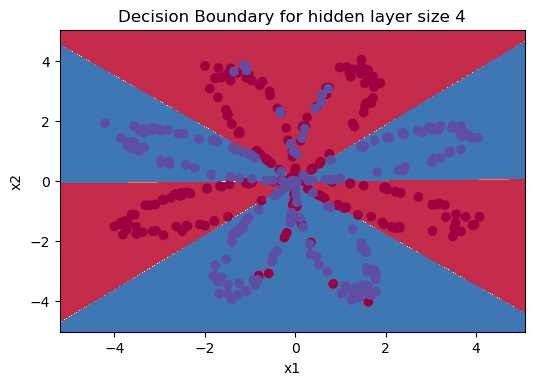
# Print accuracy
predictions = predict(parameters, X)
print ('Accuracy: %d' % float((np.dot(Y,predictions.T) + np.dot(1-Y,1-predictions.T))/float(Y.size)*100) + '%')
Expected Output:
| Accuracy | 90% |
与Logistic回归相比,准确性很高。这个模型已经学会了花的叶子图案!与Logistic回归不同,神经网络甚至能够学习高度非线性的决策边界.现在,让我们尝试几个隐藏层的大小。
4.6 - Tuning hidden layer size (optional/ungraded exercise)(调整隐藏层大小)
您将观察不同隐藏层大小的模型的不同行为。
# This may take about 2 minutes to run
plt.figure(figsize=(16, 32)) # 设置图像大小
hidden_layer_sizes = [1, 2, 3, 4, 5, 20, 50]
for i, n_h in enumerate(hidden_layer_sizes):
plt.subplot(5, 2, i+1)
plt.title('Hidden Layer of size %d' % n_h)
parameters = nn_model(X, Y, n_h, num_iterations = 5000)
plot_decision_boundary(lambda x: predict(parameters, x.T), X, Y)
predictions = predict(parameters, X)
accuracy = float((np.dot(Y,predictions.T) + np.dot(1-Y,1-predictions.T))/float(Y.size)*100)
print ("Accuracy for {} hidden units: {} %".format(n_h, accuracy))
Accuracy for 1 hidden units: 67.5 % Accuracy for 2 hidden units: 67.25 % Accuracy for 3 hidden units: 90.75 % Accuracy for 4 hidden units: 90.5 % Accuracy for 5 hidden units: 91.25 % Accuracy for 20 hidden units: 90.5 % Accuracy for 50 hidden units: 90.75 %

Interpretation:
- 较大的模型(有更多的隐藏单元)能够更好地适应训练集。直到最终最大的模型过拟合数据。
- 最好的隐藏层大小似乎在n_h=5左右。实际上,这里似乎与数据很好的吻合。同时也不好引起明显的过拟合。
- 稍后你还能了解正则化(regularization),他允许你使用非常大的模型(例如n_h = 50),而且没有太多过拟合。
Optional questions:
- 可以将tanh激活函数改成 sigmoid() 和 relu 激活函数时,会发生什么?
- 修改学习率(learning rate)
- 如果更改数据集怎么办?
你已经学会了:
- 建立一个完整的隐藏神经网络
- 充分利用一个非线性单元实现前向传播和反向传播,并训练一个神经网络
- 看看改变隐层大小的影响,包括过拟合。
5 - Performance on other datasets
如果需要,可以为下列每个数据集重新运行整个notebook(减去DataSet部分)。
# Datasets
noisy_circles, noisy_moons, blobs, gaussian_quantiles, no_structure = load_extra_datasets()
datasets = {"noisy_circles": noisy_circles,
"noisy_moons": noisy_moons,
"blobs": blobs,
"gaussian_quantiles": gaussian_quantiles}
### START CODE HERE ### (choose your dataset)
dataset = "noisy_moons"
### END CODE HERE ###
X, Y = datasets[dataset]
X, Y = X.T, Y.reshape(1, Y.shape[0])
# make blobs binary
if dataset == "blobs":
Y = Y % 2
# Visualize the data
plt.scatter(X[0, :], X[1, :], c=Y.reshape(200), s=40, cmap=plt.cm.Spectral);
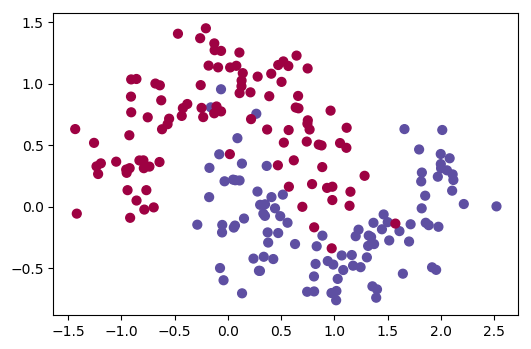
parameters = nn_model(X, Y, n_h=5, num_iterations = 5000)
plot_decision_boundary(lambda x: predict(parameters, x.T), X, Y)
predictions = predict(parameters, X)
accuracy = float((np.dot(Y,predictions.T) + np.dot(1-Y,1-predictions.T))/float(Y.size)*100)
print("Accuracy: ", accuracy)
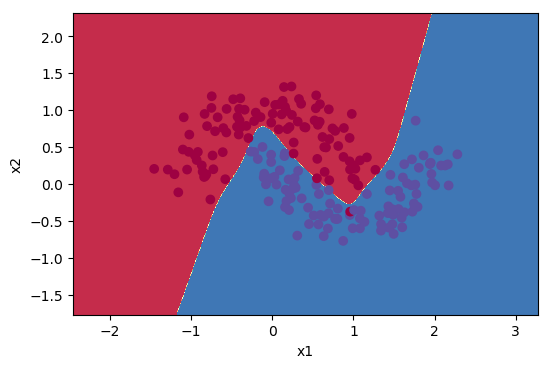


 浙公网安备 33010602011771号
浙公网安备 33010602011771号